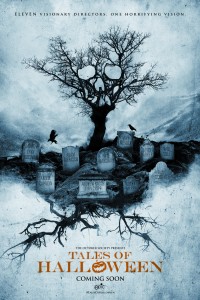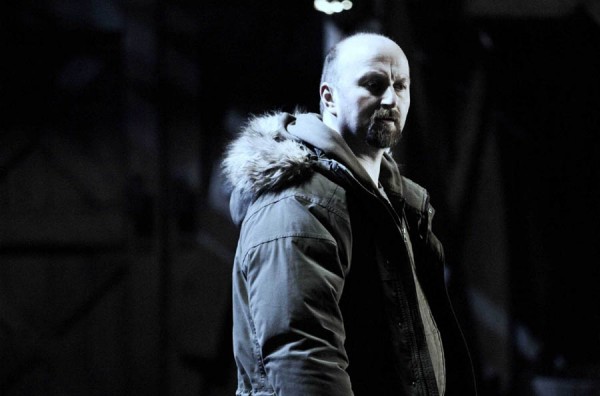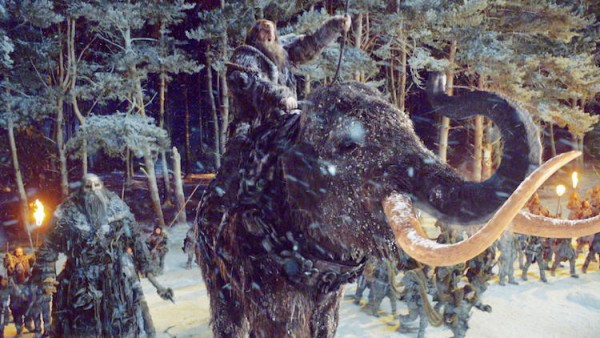Neil Marshall and I spoke at something like 11:30pm on a Thursday night. He was on day two of a three day shoot for his segment in the new horror anthology, Tales of Halloween. If he wanted to be a jerk to me, I would’ve understood. As you’ll see in this interview, Neil was working on his tightest shoot in over 15 years and wrangling a lot of technical aspects in the process. When I arrived to set (a location shoot in Eagle Rock), there was an intensely-lit house with a fog carpeted lawn standing out amidst a neighborhood of early Christmas decorations. A little farther down the street, some crew members were adjusting the levels of a flame bar. Later, Neil drove his own car up onto the curb, inches from a fire hydrant and the same crew members calibrated the height of a geyser of water. Someone in a blood soaked hazmat suit sheepishly walked past me on the way to the craft service table. It was a blast.
Like I said, Neil could have been justifiably cranky and exhausted for this interview, but he wasn’t. The publicist arranged to have me speak with him in the middle of his lunch break and even that didn’t seem to bother him. So a huge thanks to Neil Marshall and the people behind the scenes who made this interview happen. We’ll be running my interviews with Pat Healy (Cheap Thrills) and Kristina Klebe (Rob Zombie’s Halloween) from the same night shortly. I should say, I interviewed them first and they filled me in a lot of details about the short before I got to talk to Neil, so thanks to them as well.
Oh and we spoke before the announcement that Neil’s Game of Thrones episode, “Watchers on the Wall” would be screening in IMAX theaters this month, so while we do talk about the episode, I don’t bring up IMAX at all. That’s why.
Without further ado…
Miles Lemaire: You’re only shooting for three nights. Is this the shortest shoot you’ve ever done?
Neil Marshall: Pretty much, given that it’s like a ten minute film. I did it back in 1999, I did a short film that was 8-10 minutes and we did that in two days. But that was a lot more contained, it was all in one place.
Miles: No fire bars on that one?
Neil: No, I guess it’s kind of ambitious, this.
Miles: I’d heard from the actors that this was a bit of a lighter tone. I’ve never been in this neighborhood before, but it definitely has a Haddonfield vibe to it. How would you describe what you’re going for?
Neil: I’d definitely say that’s the vibe we were trying to achieve with the neighborhood and the place where all of the stories are set. It’s supposed to be a small town, somewhere in the United States—we’re not saying where it is—but it’s one town, one night (Halloween) and all of these different stories taking place in and around the town and there are threads that link them.
Miles: And Kristina (Klebe) told me that her role was originally written for a male character?
Neil: It was. I kind of automatically wrote it as a guy and I met Kristina for the first time shortly after that and I actually think it was my wife Axel—who is the producer and basically came up with this idea in the first place—she said, “did you ever think about Kristina for the cop?” And it was like, no I didn’t, but that’s a really cool idea. So I quickly rewrote it, offered Kristina the role and she was like, “yeah, I’ll do it.”
(Note: Neil was wearing a replica of Harry Dean Stanton’s baseball cap from Alien)
Miles: Well it’s perfect because you’ve got your Nostromo hat on and Ripley was probably the most famous character to have been gender-swapped like that.
Neil: Yeah, definitely.
Miles: So this is night two: what do you have left to film tonight? You’re breaking for lunch now, this is crazy! What time do you plan to wrap tonight?
Neil: Around 5am, I think it is.
Miles: Wow, so you still have quite a bit to do and you’re doing practical effects work from what I’ve heard.
Neil: We’re trying to do as much practical effects as possible. We’ll need a little bit of CGI enhancement every once and a while, but we’re trying to do as much in-camera as we can. It’s kind of a throwback to the ’80s, I suppose, because I just love all that kind of stuff. Yeah, we still have a lot left to do tonight, because we essentially have the finale of the movie to film and we’re trying to fit it all in in half a day.
Miles: And on a three-day shoot like this, how much preproduction are you able to do when everything else is meant to run so quickly?
Neil: We did as much as possible. I kind of set the wheels in motion to create the pumpkin earlier than anything else because that was going to take the longest. But then it was just a question of getting the cast and getting the locations and everything else sort of just fell into place. So there’s not a whole lot of preproduction that you can do.
Miles: Are you doing another episode of Game of Thrones for their next season? Your episode, “Black Water” was one of my all-time favorites and I loved how you made the combat look messy and frightening. Can you talk a little about pulling that off and working for television vs. working for film? I’d imagine the shooting schedule was closer to what you’re doing here than any of your film work.
Neil: I think a lot of it had to do with the fact that it was kind of messy and quick. I only had a week’s prep on that. And then reason that that came about was because they had an original director lined up for that episode and he had to leave for personal reasons a week before the shoot and there was literally nothing in place. They’d begun to build sets, but that was it. So they needed somebody in a hurry and the stunt coordinator from my previous film Centurion was then working on Game of Thrones and he literally just handed them and call and said, “give Neil a call, he knows how to do this stuff. Here’s his work.” So I got the call on a Saturday and started work on Monday with a week’s prep to do it. It was just nuts.
Miles: And with “The Watchers on the Wall” was that a similar amount of prep or did they give you more time now that you had already…
Neil: I believe I had four week’s prep on that one.
Miles: Oh wow, that’s incredible.
Neil: Yeah and we needed it for that one. It was vastly more complicated.
Miles: It’s huge! That tracking shot was unbelievable.
Neil: weirdly, that was one of the easier things to do. That was—I came up with the idea, made sure that it was totally justified as a shot—I didn’t want it just to be a pretty shot for the sake of being a pretty shot—it did something for the story and tied all of the characters together geographically—so I planned it that way and literally, we rehearsed it and blocked it for like an hour and then we got it in seven takes and that was it. So that was relatively easy. It was the stuff with the mammoths and the soldiers that was tough. Because the mammoths were 100% CG. The giants were real giants, but they were blown up to twice the size. They’re real guys, like seven and eight-foot tall guys that were doubled in size. So there were visual effects through every component of those shots and putting it all together, that’s really complicated.
Miles: That’s incredible. And—knowing that IMDB is often quite wrong about these things—are you working on Skull Island next?
Neil: Yeah, well it gets itself in a mess and once mistakes are in there it’s very difficult to change them. No, the way it is is, myself and another writer did a spec script called “Skull Island” about two or three years ago for a movie. And ours is like a period piece. It has pirates on Skull Island, so it was kind of like, pirates and dinosaurs, what more do you want? And so pitched it around the studios and nobody bit. Universal wasn’t interested in doing another King Kong thing, so nothing ever really happened with it, so it went away. And then later someone—it wasn’t me—posted it on my IMDB page as, “Skull Island: Blood of the King” which is actually the wrong title.
Miles: Yeah, that’s why I was hesitant to ask. And not only that, but they’re saying it’s a sequel, when everything we’ve heard about the new film is that it’s a prequel.
Neil: Yeah, so it’s weird, because it’s half the facts and the other half are wrong. Like, they said it was prequel, which it’s not. Ours was a prequel. They said it’s called “Blood of the King” and ours was actually called “Blood of the Kong.” And then it was left and we never heard anything about it, until Legendary announced they’re making Skull Island and Comic Con. And suddenly everyone is patting me on the back and saying, “congratulations! You’re making the film!” And I’m like, did you ever hear my name in that announcement anywhere?
Miles: Right, but I do get why everyone would be so excited, because when I first heard your name attached in this way, I thought, Neil’s perfect for that.
Neil: I would LOVE to do it. I just think that world is so awesome. And our script, the idea was pretty cool. We had pirates on Skull Island and the origins of King Kong. And it was kind of about King Kong’s parents and Kong is just this little guy. And ours explained why there are giant gorillas on the island.
Miles: So was it—and I don’t want to compare it to a film that you and your co-writer couldn’t have possibly seen while you were working on the script—but was it at all like Dawn of the Planet of the Apes where there’s a long stretch of silent filmmaking, just dealing with Kong’s parents?
Neil: Well the script was told from a human point of view, because it was these pirates that end up on the island for their own reasons, but there was a very strong storyline involving Kong’s parents and Kong himself. Though I suppose we would have gotten Andy Sirkis in to do it if it had gone through!


